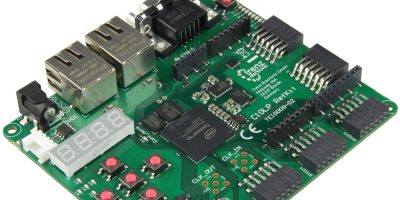Arrow Electronics has introduced the Cyclone® 10LP Refkit Industrial to accelerate development of smart and connected solutions for diverse applications including Industrial IoT, automation, communications, computing, and smart energy.
Building on the existing commercial Cyclone® 10LP reference kit, Arrow has worked with technical collaborator Trenz Electronic, co-developer of the commercial board, to strengthen the design for industrial deployments.
The new Cyclone® 10LP Refkit INDUSTRIAL packs 128MBit on-board Flash to host complex and flexible applications and is especially suited to applications involving industrial Ethernet connection and Time Sensitive Networking (TSN). All Flash and DRAM chips are specified industrial temperature grade, and the Intel Cyclone® 10 LP 10CL055YU484I7G FPGA at the heart of the board is a fast speed grade, industrial-temperature rated device. The FPGA contains 55,000 logic elements and 156 DSP blocks, with 2.34 Mbit embedded memory and 321 I/Os for designers to configure and employ in their applications.
Arrow offers flexible support services for customers using the kit, including help with custom PCB modifications, developing alternative form factors if needed for fitting, integrating alternative devices on the board, and unleashing the potential of the Intel Cyclone® 10 LP FPGA on-board. The Intel Cyclone® 10 LP targets industrial and embedded applications, with extensive features and performance for edge applications, low power consumption, high efficiency, and capacity to host AI algorithms.
The new industrial-ready board, part number TEI0009-02-PHIQ2R, is available now from https://www.arrow.com/en/products/tei0009-02-phiq2r/trenz-electronic-gmbh







